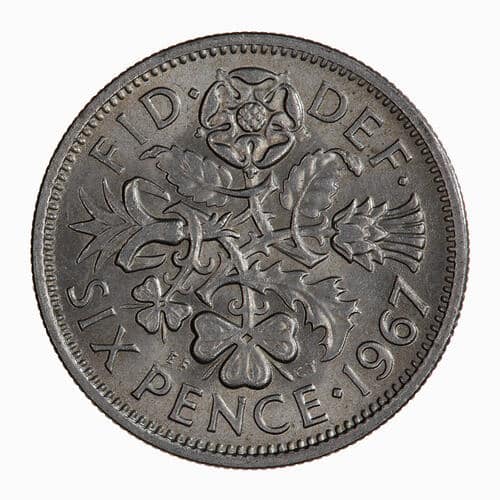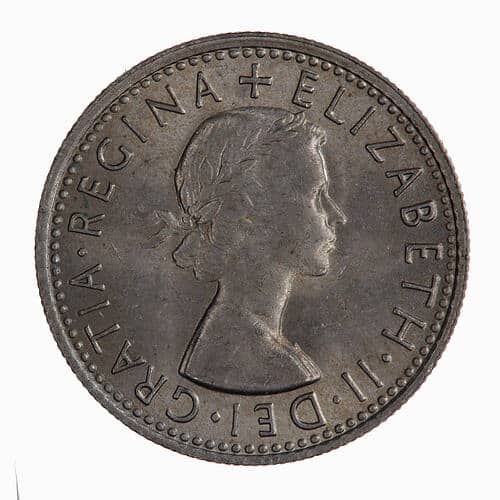If you’ve come across a 1967 sixpence, you may wonder how much it’s worth.
Unfortunately, this coin is not considered rare, and you can expect to sell one for roughly £1 on eBay according to the latest values in 2022. Highly graded versions can sell for between £5 and £10 but are uncommon.
Let’s take a deep dive into the 1967 sixpence to see why it isn’t worth a fortune like some other pre-decimal coins.
The Last Circulating Sixpence
Before decimalisation in 1971, pre-decimal coins such as the sixpence were still issued most years.
Leading up to the decimalisation, however, the production lowered significantly which meant that 1967 was the last year of sixpence coins being issued into circulation.
Many people believe that the 1970 sixpence was the last circulating sixpence, but they were only produced in proof finish for collectors and were not used in circulation. This is all well and good, but the real question is whether this makes the 1967 sixpence rare or not?
Why Isn’t The 1967 Sixpence Considered To Be Rare?
To put it bluntly, the 1967 sixpence isn’t rare whatsoever, but it does still hold some sentimental value as the last circulated sixpence to ever be issued.
The reason why it isn’t rare is simple – it had a mintage of 240,788,000.
A mintage of around 240 million is incredibly large and means that the value of the coin today is very low.
In fact, pretty much every auction listing for sixpences of this era is presented as large collections due to this fact.
Are There Any Other Versions?
Unfortunately, there aren’t any other versions of the 1967 sixpence. Unlike most coins that are in circulation today, it was not as common for the Royal Mint to issue collector versions back then.
When Did The Sixpence Go Out Of Circulation?
The sixpence ceased to be legal tender in 1980 and was withdrawn from circulation.
It’s quite interesting that it continued to circulate even after decimalisation for roughly 9 years. This was a strategy to ease the transition period, and the value of the coin was translated to 2.5 new pence during this period.
Design Of The 1967 Sixpence
The reverse design of the coin shows four plants – rose, thistle, shamrock and leek – which are interlocked together. These are the four plants of the countries of the United Kingdom and have been featured on many coins since such as many modern £1 coins like the Leek or Thistle £1 coins.
This design was created by Edgar Fuller, the man responsible for the 1953 Coronation crown coin design, and has the inscription ‘FID · DEF ·’ above and ‘SIX PENCE · 1967’ below.
The obverse side shows the first coin portrait of Queen Elizabeth II, known as the young head portrait, which was used between 1953 and 1970. The Queen is facing right, and the inspiration for the design was taken when the Queen first took to the throne at just 27 years old.
This was designed by Mary Gillick and is an easy way to identify pre-decimal coins issued from 1953. The inscription ‘+ ELIZABETH · II · DEI · GRATIA · REGINA’ around the edge translates to Elizabeth the Second, by the grace of God, Queen from Latin.
The edge of the 1867 sixpence is milled.
Is The 1967 Sixpence Made From Silver?
There is a common misconception that the 1967 sixpence alongside most other sixpence coins were made from silver, but this is not entirely accurate.
The composition of the sixpence was 92.5% silver before 1920, and after this, it changed to 50% due to the rise in the price of silver bullion.
In 1947 the silver composition was changed from 50% to 0%, as the decision was made to get rid of the silver content entirely due to the economic impact of World War 2.
This is another factor as to why the 1967 sixpence is not worth a whole lot, and you can find the other specifications for the coin in the table below.
| Diameter (mm) | 19.30 |
| Weight (g) | 2.83 |
| Alloy | Cupro-Nickel |
Final Thoughts
Although a 1967 sixpence isn’t the rarest pre-decimal coin, it’s still a nice memento of the period right before decimalisation.
It also makes for a great wedding or birthday gift!

